Hydrangea Rose Bouquet - how to grow a gorgeous plant
Perennial decorative hydrangea Rose bouquet native to the south of Chile, Andes, North America, East and South Asia, has become widespread in our country. This large-leaved and lushly flowering shrub has good frost and winter hardiness. Consider its characteristics, planting and care rules.
- Description
- Landing rules
- Timing
- Seat selection
- Preparation of planting material
- Landing technique
- Care features
- Watering
- Top dressing
- Pruning
- Preparing for winter
- Possible growing problems
- Reproduction methods
- Cuttings
- By dividing the root
- Stem layering
- Diseases and pests
- Application in garden design
- Testimonials
- Useful videos
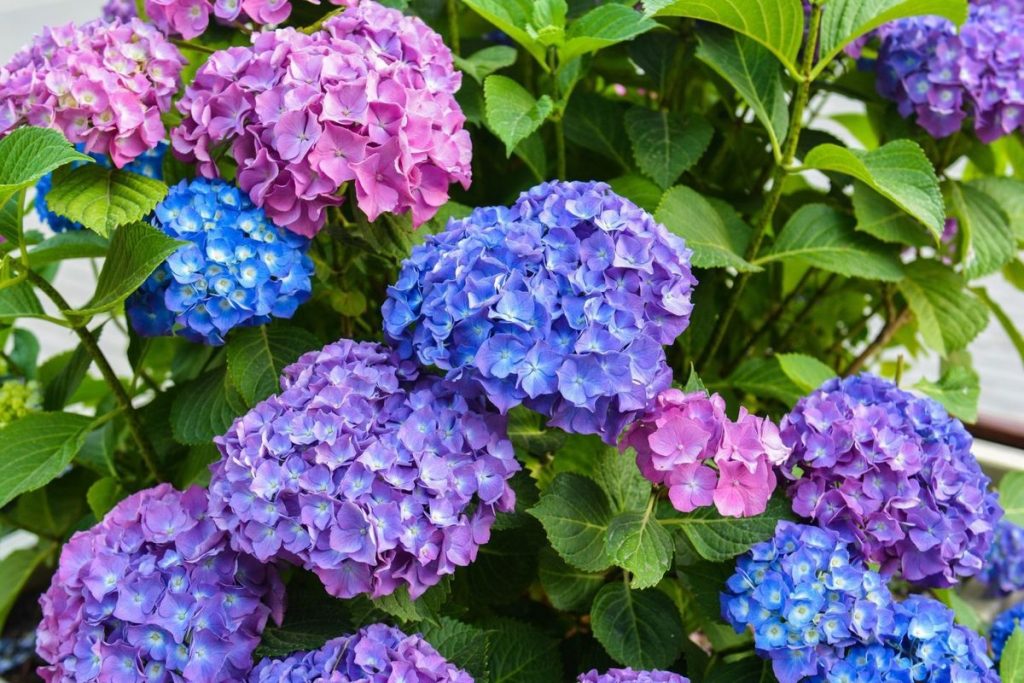
Hydrangea bouquet rose reviews
Description
Garden large-leaved hydrangea Rose Bouquet is valued for its long flowering (lasts from early summer to early September).
The botanical name of the species is hydrangea macrophylla Bouquet Rose.
The variety belongs to the ornamental garden variety. A deciduous shrub with a lush spherical crown and erect shoots. It grows very quickly - it can stretch by 20-25 cm in a year.
The height and width are approximately the same size - 1-1.3 m, when grown in containers, the plant turns out to be dwarf, the maximum length of the stems is 50-60 cm.
The leaves develop oppositely, the shape is oblong-ovate, emerald above, rough, covered with white villi, below - light green velvety.
Small flowers of two tones - pink-lilac and greenish-blue hues, collected in dense umbrellas up to 25 cm in diameter. The tone of the inflorescences depends on the acidity of the soil - at a high rate, the buds are bluish, if it grows on slightly acidic ground, the flowers are pink;
The root system is located close to the surface, well branched, often forms many offspring, due to which the bush grows in breadth.
Landing rules
The successful cultivation of this crop depends on strict adherence to all planting and care rules.
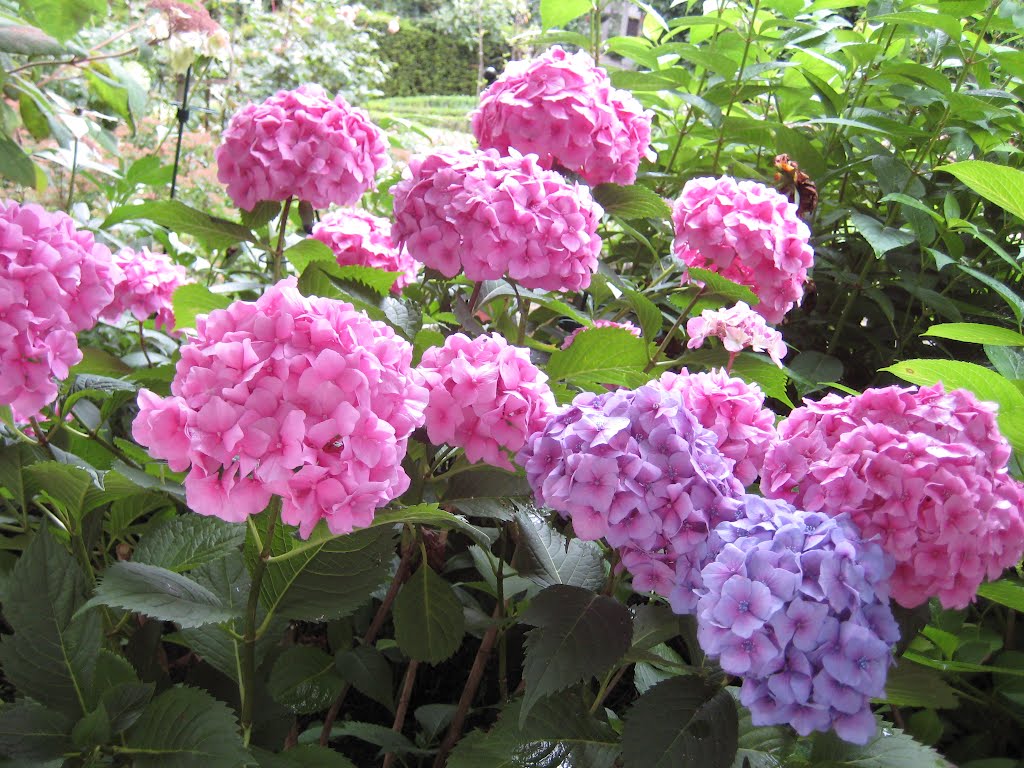
Hydrangea bouquet rose photo
Timing
Depending on the climatic zone, the time for planting seedlings may differ:
- in the south, in the Middle and Central zone, this can be done both in spring and early autumn (until the first half of September);
- in regions with severe winters and short summers (in the Urals, Siberia, in the North) they are planted in spring.
The main conditions for successful survival are a stable temperature (5-8 ° C), no frost and well-heated soil up to 10-12 ° C.
Seat selection
For growing large-leaved hydrangea, a sunny or slightly shaded place without drafts and boggy is suitable.
The shrub should not be planted next to trees or other tall plants, as competition for moisture and nutrients can arise between them.
The main requirements for the soil are good moisture, acidity level 7-8 units, light and loose structure.
When planting on sandy loam, you will need to add 20 kg of clay per 1 m². If cultivation is planned on clay soil, add two buckets of vermiculite, perlite or sand to the same area.
The landing site is prepared in advance - 4 weeks in advance.It is freed from garden debris, last year's vegetation, dug up to 20 cm depth, then leveled.
Preparation of planting material
Seedlings Bouquet Rose can be purchased at an affordable price in one of the specialized nurseries. Choose mature and grown specimens in which the crown consists of a central branch and several skeletal shoots. Such bushes have a well-developed root system, which means they will safely transfer the transplant to the site.
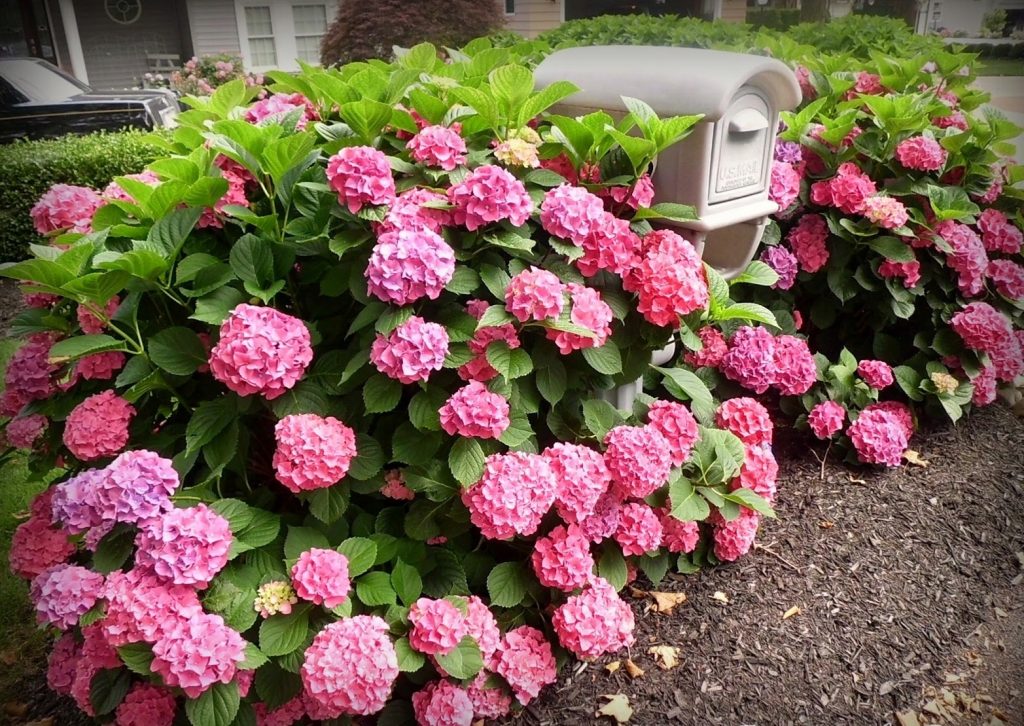
Hydrangea bouquet rose description
When choosing, carefully inspect the stems, buds, leaves - they must be fresh, without mechanical injuries and signs of disease and pests.
Plants with an earthen clod or planted in containers are considered the best material. They are protected from drying out. If you buy bushes with open roots, you need to immediately cut them 2-3 cm in length, put them in water for a couple of hours, then plant them. If this is not done, the shrub will dry out.
The procedure for soaking the roots before planting is also used for closed-rooted hydrangeas. Moisture-infused roots will take root faster.
Landing technique
Pits are dug two weeks before the planned planting so that the earth and nutrients have time to settle. Their approximate dimensions are 40x50x40 cm.
A couple of handfuls of pebbles, rubble or dropouts are poured into the bottom to ensure a good outflow of moisture. A small layer of a mixture of dug, turf soil, compost (last year's manure) and peat is poured on top in a ratio of 1: 1: 1: 1. To this composition add 50 g of superphosphate and 40 g of potassium fertilizer.
They form a mound of plain soil, lower the roots so that the root collar remains above the surface of the soil. Fall asleep to the top with soil mixture, crush around the stem, moisten. At the very end, they bring in mulch from peat or humus.
Care features
This culture, undemanding in keeping and growing, needs periodic moistening, feeding, loosening and pruning. If you give it a little attention and care, the large-leaved hydrangea will reward you with an attractive appearance and long flowering.
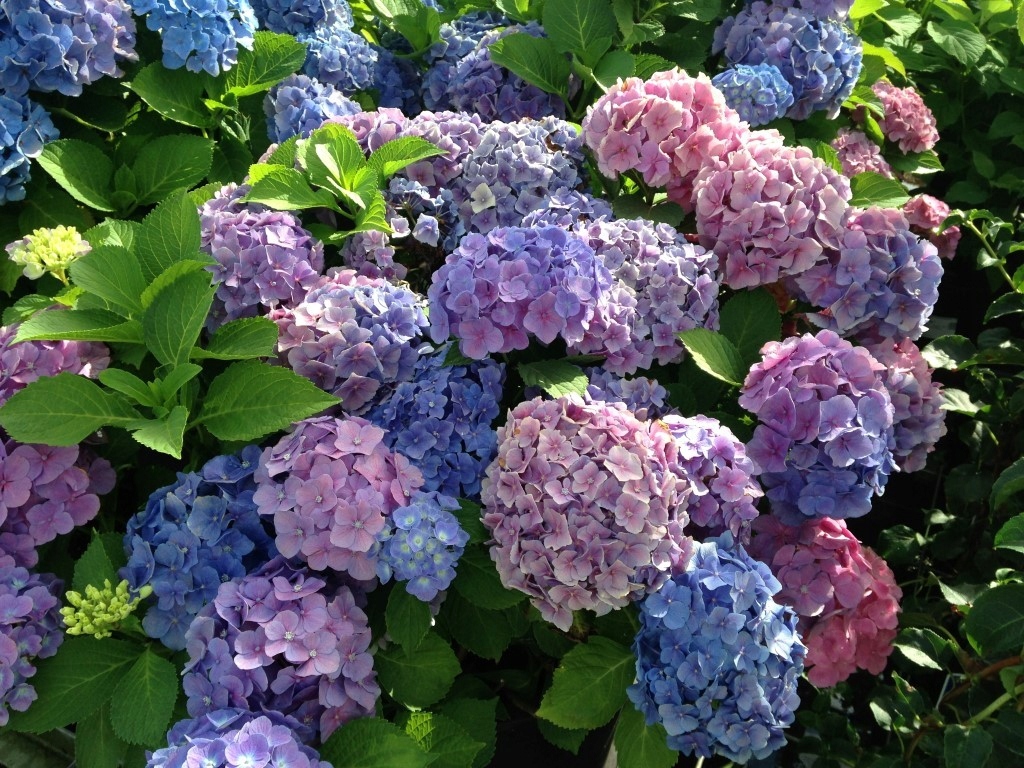
Hydrangea bouquet rose planting and care
Watering
Loves moisture very much, but in moderation, so the soil should be slightly damp. To ensure this, in spring and summer, frequent, but moderate watering is carried out - every three days. Consumption per bush - 5-6 liters.
Immediately after planting, young plantings are moistened every day for a month. Moisture helps the root system to grow new shoots. Adults water several times per season - in early spring, before flowering and two weeks after it, as well as in late autumn. The amount of water for one plant is 20 liters. Additionally moisten as the soil dries to a depth of 5-6 cm.
After each moistening, the soil is loosened, weeded between the rows, weeds are removed, mulched with peat, sawdust or humus.
With group planting, the distance between the seedlings is maintained - about 1 m.
Top dressing
They begin to feed in the third year of cultivation according to the following scheme:
- in early spring, at the stage of swelling of vegetative buds, nitrogen-containing substances are introduced to stimulate the growth of stems and leaves;
- a week before budding at the end of May, fertilize with phosphorus-potassium preparations, which increase the quality of flowering;
- in the fall, after the inflorescences dry out, compost or humus is embedded in the near-stem zone.
After each feeding, abundant watering is carried out so that the roots quickly absorb the nutrients and do not get burned.
Pruning
This is one of the must-have procedures for the care of hydrangea rose bouquet. In early spring and late autumn, unviable stems are cut out - frozen, broken off, dried up. Additionally, cut off inflorescences that have dried up to extend the flowering period.
In the summer, when the shrub intensively builds up its green mass, the branches that grow inward or at the wrong angle are pruned.
All manipulations are carried out with a sharp and sterile instrument. To avoid infection with diseases after the procedure, the crown is irrigated with copper sulfate.
Preparing for winter
After the autumn pruning, young plantations up to three years old require good insulation, which will protect them from freezing in winter.
2 weeks before the upcoming frost, the trunk circle is mulched with peat or last year's manure. The branches are tied in a bundle, bent to the ground, fixed with staples, covered with fallen leaves, sawdust or covered with spruce branches.
In the spring, when the snow thaws, the threat of recurrent frosts has passed, the insulation material is removed, the twigs are dismissed.
Possible growing problems
When caring for a large-leaved hydrangea, gardeners face different problems. The main causes and their consequences:
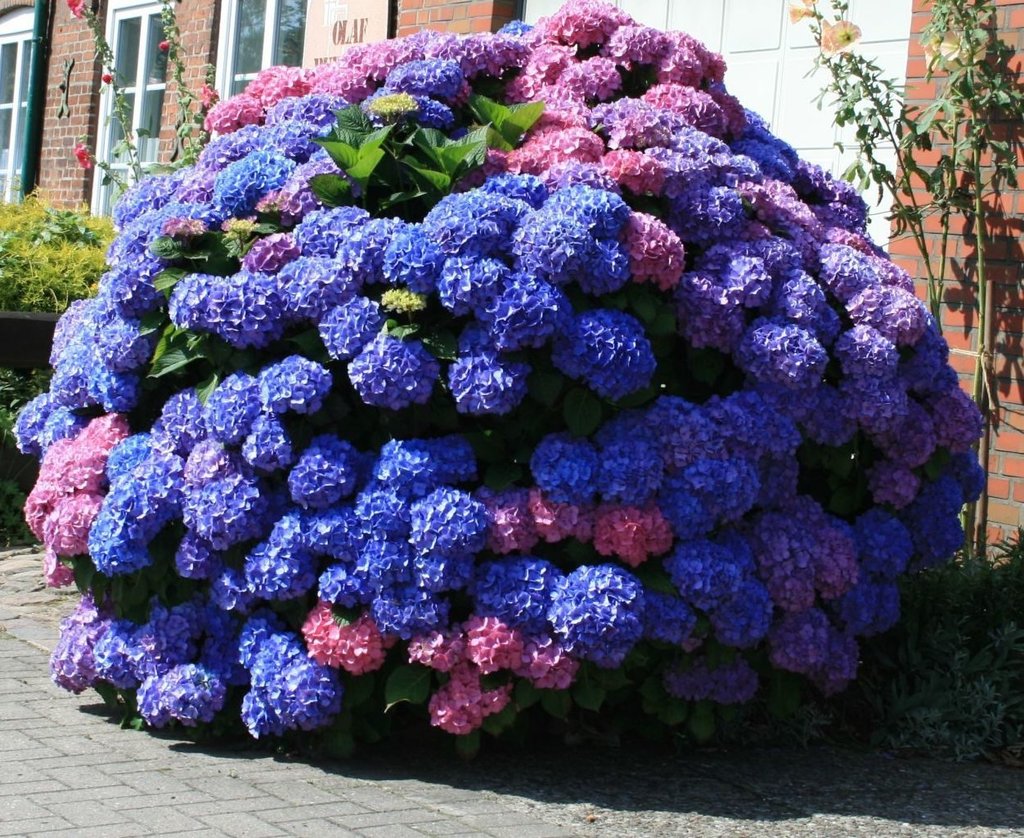
Hydrangea large-leaved bouquet rose planting and care
- planting too early, as a result of which the seedlings freeze and die;
- planting bushes in heavy, scarce land, where they root poorly, grow slowly and do not release inflorescences;
- insufficient or excessive watering leads to drying out or rotting of the roots, respectively;
- cardinal pruning of shoots, from which the hydrangea withers or blooms poorly next year;
- violation of the scheme during group planting - closely planted bushes begin to hurt, suffer from a lack of light, moisture and nutrients.
If all these problems are eliminated, the plant will recover, will delight the former beauty and attractiveness.
Reproduction methods
You can propagate a hydrangea of this variety in several ways, for success it is important to properly prepare and plant the material.
Cuttings
Annual green shoots are taken from the top of the lignified stems. The main requirement is the presence of leaves, buds and at least one internode. In the lower part, all the leaves are cut off, dipped in Kornevin's solution for an hour.
Then they are planted in a seedling box filled with a peat-sand mixture. The depth of planting cuttings is 3-4 cm. After planting, they are watered, covered with a transparent covering material, and placed in a warm place.
Every day, the seedlings are ventilated, moistened as necessary. As soon as leaves appear on them, the shelter is removed. This is a sign that they have taken root. After a month of growing, they will be overgrown with roots, then they can be transplanted into open ground.
By dividing the root
They are engaged in such reproduction in the fall. Use old shrubs that need to be rejuvenated. They are watered, dug in an hour later and removed from the soil. Wash off all the earth, after drying, divide the rhizome with a garden shovel. For successful rooting, each section should have one stele with buds and roots.
Places of cuts are irrigated with copper sulfate, dried, seated separately.
Stem layering
An adult shrub with well-developed stems in the lower part is required. Choose the most flexible lignified branch, close to the ground. Remove foliage on it. A trench 5-6 cm deep is dug side by side, the bottom is sprinkled with a mixture of humus, peat and sand (1: 1: 1). A twig is laid in it in a horizontal position, fixed with brackets, covered with soil mixture, watered.
Closer to the first autumn frosts, they mulch with insulating material - fallen leaves, sawdust or compost.
In the spring, when the heat of the street stabilizes, the twig is dug up, cut off from the main plant, and divided into parts with roots. They are planted in the same way as purchased flowers.
Diseases and pests
If the basic rules of care and maintenance are violated, this perennial culture is affected by various diseases and insects:
- Powdery mildew. Signs - whitish bloom on stems, leaves, later turns brown. Places damaged by a fungal infection die off. The treatment is carried out in two stages - first, the diseased areas are removed, then the crown is irrigated with Topaz, Skor or Ridomil gold.
- Rust.Reddish shapeless growths on the surface of branches, foliage. Infected parts dry and fall off. Treatment is carried out with fungicides - a solution of copper sulfate or Bordeaux liquid.
- Among insects, it affects aphids, spider mites, and nematodes. Insecticides will help to cope with parasites - Actellik, Aktara, Fitoverm.
Application in garden design
In garden design, Bouquet Rose hydrangea is used in several variations:
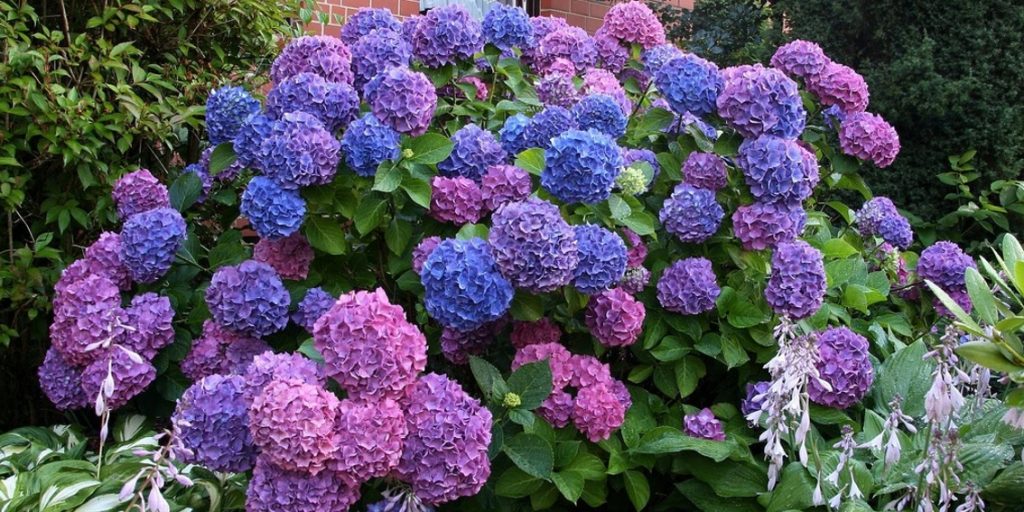
Hydrangea large-leaved bouquet rose planting
- planted singly in flower beds, near gazebos, along the edges of the flower garden;
- grown in groups in combination with other varieties, creating a multi-colored hedge;
- combined with low-growing decorative deciduous crops - junipers, hosts, heather and mosses.
Testimonials
This plant is especially popular with gardeners and has earned many positive reviews:
- due to its good winter hardiness, large-leaved hydrangea withstands different temperature changes, while it does not freeze and blooms colorfully every year;
- it can grow both in the sun and in a shaded place, which allows its cultivation in any corner of the garden;
- easily multiplies in different parts, which significantly reduces the cost of purchasing new seedlings;
- perfectly combines and transfers the neighborhood of other decorative vegetation, which makes it possible to create the most unusual and unique composition in the garden.

